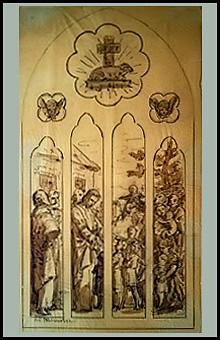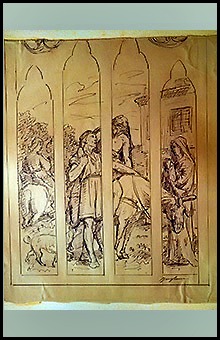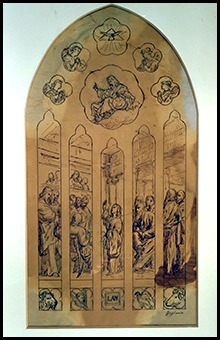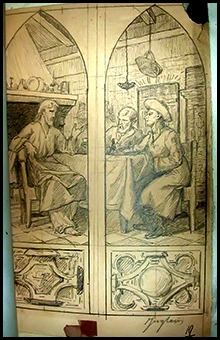

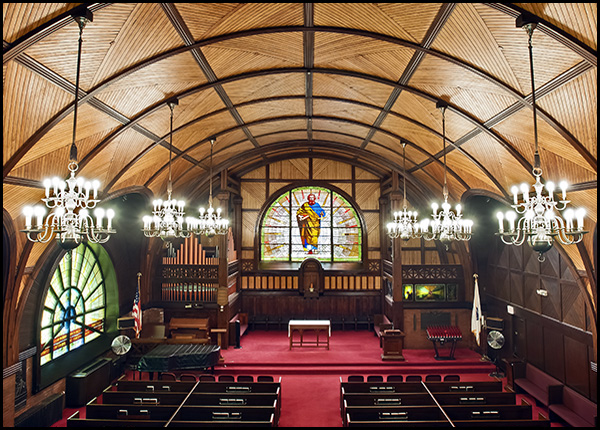
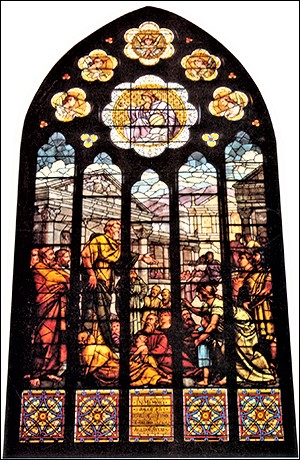
In 1880 Juglaris accepted the post of executive director or executive artist at Boston’s Louis Prang & Company with the understanding that he would be working strictly half-time, enabling him to devote the rest of his working week to the fine and decorative arts. Although the post with Prang did not last, an invitation from Boston stained glass manufacturer Donald MacDonald opened up a whole new field for Juglaris. In collaboration with Donald MacDonald, as well as others, Juglaris became a successful stained glass designer, using his talents and skills to create what were, in effect, murals on glass.
For America, it was a great era of church building. Juglaris was commissioned to prepare stained glass window designs for churches in Boston, New York City, and San Francisco. In the vicinity of Boston, he designed large monumental windows for the Tufts College Chapel (Goddard Chapel), Channing Memorial Church (today Newton Presbyterian Church), the Hollis Street Church, the Second Congregational Church of Boston, and People’s Church (Methodist), serving New England’s largest Protestant congregation. At least one secular commission was also forthcoming. As a newspaper article from the Providence Evening Telegraph notes, “one of [Juglaris’s] productions that has brought him fame is a stained glass window in Memorial hall at Harvard university” [sic]. Through a careful process of elimination and direct evaluation of stylistic content, Juglaris’s work at Harvard’s Memorial Hall is readily identifiable as the double panel John Hampden and Leonidas stained glass window manufactured by Daniel Cottier and installed in 1882. It commemorates Harvard students and alumni who sacrificed their lives in the American Civil War. The Leonidas panel displays Juglaris’s distinctive flair for “drapery.” The beautiful folds of Leonidas’s clothing are not only reminiscent of what is found in the St. John and St. Paul windows of Goddard Chapel at Tufts University but also with the eight monumental muses of the Michigan State Capitol rotunda.
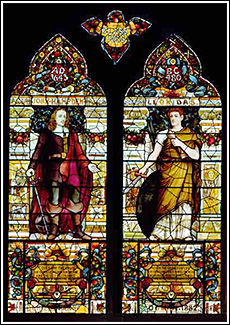
The John Hampden and Leonidas window commission may have been facilitated by Martin Brimmer, an active Harvard alumni and president of the Boston Museum of Fine Arts. Brimmer, whom Juglaris came to know well, is frequently mentioned in the artist’s memoir. The Harvard College commission placed Juglaris in the company of other prominent stained glass designers of that era who are likewise represented by Memorial Hall windows, namely, Donald MacDonald, Daniel Cottier, Francis Millet, Frederic Crowinshield, John LaFarge, Edward Simmons, and Sarah Wyman Whitman.
Juglaris’s memoir records that he, along with Donald MacDonald, was commended for the originality of his stained glass designs, which is borne out by newspaper accounts. Commenting on one of the windows that Juglaris and McDonald completed at the Hollis Street Church in Boston as a memorial to Reverend John Pierpont, the grandfather of the financier John Pierpont Morgan, the Boston Daily Globe for November 2, 1882 states: “It is a superb specimen of mosaic work… It shows nothing of the crude, conventional art as is often seen in stained glass windows.” Likewise, with regard to another apparent Juglaris-MacDonald collaboration from the MacDonald workshop, executed for the apse of the Channing Memorial Church in Newport, Rhode Island on the biblical theme of the Sower, the Globe on March 24, 1883 writes: “The tints are exceedingly rich, deep, and harmonious, and yet so subdued as to have the appearance of a warmly colored mural painting, while the changing effects of light and shade, as the sun’s rays without shift and vary, are an exceedingly fascinating study.” Although taking obvious inspiration from a famous mid-nineteenth century painting by French artist Jean Francois Millet, the nine-panel Channing Memorial window places the Sower in the midst of a richly variegated, panoramic landscape that utilized Juglaris’s talent for depicting nature’s contours.
At the same time, not everyone took the same pleasure in the aesthetic sensibility that Juglaris brought to his work with MacDonald and others. A young Ralph Adams Cram, who later went on to great fame as an architect of collegiate and ecclesiastical buildings, was working for the Boston architectural firm of Rotch and Tilden and moonlighting as critic for the Boston Evening Transcript from 1884 to 1887. In his “Art Notes” column for March 23, 1885, Cram reviewed Juglaris’s 1885 Boston exhibition with extensive comment on the artist’s stained glass designs for the Tufts College Chapel, and the Channing Memorial Church at Newton, Massachusetts (now Newton Presbyterian Church). He praised Juglaris’s use of color as “wonderfully good.” He further remarked on the adeptness with which Juglaris draped and clothed his figures. But Cram found other elements of Juglaris’s stained glass design less gratifying. As Cram wrote:
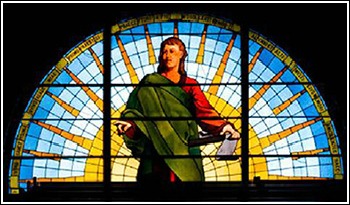
“The [Juglaris] cartoons are broad, firm, academical, unexpressive in the faces occasionally, and sometimes ungracefully posed but always boldly drawn and particularly good in point and drapery. The ‘St. Paul at Athens’ [for the Channing Memorial Church at Newton] strikes one as hardly successful in grouping, while the post of the figure of the preacher is undignified and without grace. The drapery is very good, notably that of the man on the extreme left. In the central compartment is a good figure of a bearded man in sudden thoughtfulness. As a whole, the figures are studied and rather characterless, while the elaborate architectural background is ludicrously incorrect, both in design and drawing. The ‘St. John’ [for the Tufts College Chapel] is bold and vigorous, but not very religious or impressive, which is the case, also, with ‘St. Paul,’ a figure somewhat huddled and unmonumental; and with the ‘St. Mark,’ who seems to be taking measurements with his stylus preparatory to sketching on his tablets. His lion is somewhat more absurd than the winged beast in the Piazetta at Venice. The ‘Christ Blessing Little Children’ is rather conventional and emotionless. Much better is the ‘Good Samaritan,’ where the figure of the youth is really heavy in its helplessness… The watercolor designs for stained glass are often brilliant and rich in well-combined color.”
Given Cram’s pronounced preference for highly traditional design which came to be expressed through his signature Gothic Revival architecture, it is not clear that he would have found the stained glass work of many of Juglaris’s contemporaries any more satisfying. Nevertheless, Cram’s observations are often perceptive and astute, highlighting both Juglaris’s strengths and weaknesses as an artist and decorative designer.
Unfortunately, some of Juglaris’s most masterful stained glass designs are no longer viewable due to the total destruction of their original sites or serious damage to the integrity of his glass work. At Tufts University’s Goddard Chapel, for instance, the St. Paul and St. Matthew Windows, cited by Cram, have over the past century sustained significant damage and literal defacement. In 1958 hurricane-force winds which swept through the campus blew in the more massive St. Paul Window. Likewise, maintenance accidents irrevocably altered the configuration and appearance of the St. Mark Window, leaving only the fully intact St. John Window above the sanctuary balcony truly representative of Juglaris’s talent and sensibility.
